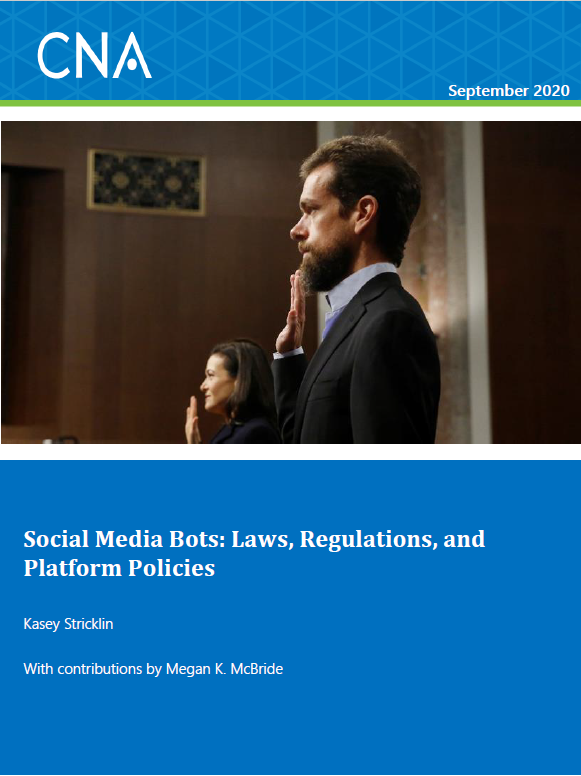Social media bots—simply, automated programs on social media platforms—affect US national security, public discourse, and democracy. As the country continues to grapple with both foreign and domestic disinformation, the laws and platform policies governing the use of social media bots are incredibly important. As part of CNA’s study, Social Media Bots: Implications for Special Operations Forces, our literature review found that the landscape of such regulations is difficult to piece together, and applicable provisions and policies are disparately catalogued. This CNA primer helps to fill this gap by helping policy-makers and national security practitioners understand the laws and social media platform policies as they currently exist. We also consider the challenges and dilemmas faced by legislators, and social media platforms, as they attempt to craft relevant provisions to address social media bots and malign influence, and we conclude with a brief look at the consequences for breaking platform policies.
The legal framework
US policy-makers are constrained in their passage of bot-related laws by a number of factors. First, legislators must consider free speech rights granted by the First Amendment of the Constitution. Additionally, Section 230 of the Communications Decency Act (CDA 230) hinders the ability of policy-makers to hold social media platforms legally responsible for any material posted on their site. Further, the slow speed of congressional action compared to technological advancement, and the barriers to obtaining reliable information on the social media bot threat, have proved difficult to overcome. There are no US federal laws governing social media automation, although members of Congress have introduced several relevant pieces of legislation over the last few years. While there is some congressional interest in crafting botrelated legislation, the political will to pass such provisions has yet to materialize.
In the international arena, the European Union has been a leader in efforts to counter disinformation; it introduced a nonbinding Code of Practice in October 2018, to which many of the most prominent social media companies signed on. As a result, the platforms committed themselves to self-regulation aimed at stamping out disinformation on their sites, which includes closing fake accounts and labeling bot communications. In May 2020, the European Commission reported that, though there were positive developments toward countering disinformation, there is still much room for improvement in labeling and removing bots. It is important to keep in mind, though, that the EU has a permanent bureaucracy to study problems and propose legally and non-legally binding legislation. In the US, legislation works differently, as a legislative champion with significant clout needs to emerge in order to push forward a proposal.
Platform policies
The social media companies face their own dilemmas when thinking about the creation of effective bot regulations. Unlike policy-makers, platforms are beholden to shareholders; and higher platform engagement generally leads to higher share values. Because bots make up a large portion of monthly active users on some platforms, the companies may be reluctant to kick off these automated accounts. However, public pressure since the 2016 US election has created a greater financial incentive to ensure engagement is authentic. The companies also worry about regulating too extensively out of fear they will then be admitting they have an affirmative duty to moderate and thus lead to the revocation of their limited immunities under CDA 230. This tension is evident in the run-up to the US presidential elections, as the social media companies seek to ensure the truthfulness of candidates on their sites, they also risk one side of the political spectrum regarding them as politically biased and seeking to regulate them in response.
Instead of specifically focusing on bot activity, the platforms tend to address bot behavior through other policies on banned behavior. We broke out the policies relevant to bots into four categories: automation, fake accounts and misrepresentation, spam, and artificial amplification. Figure 1 depicts the way these policies often overlap in detailing prohibited bot behaviors.
The consequences for breaking platform policies vary, with the sites often looking at the specific violation, the severity of the infraction, and the user’s history on the platform. While they may simply hand out a warning or restrict the post’s viewership, the sites also reserve the right to ban users or accounts, and can even go so far as to sue for violation of their terms.
The ever-evolving threats from disinformation and malicious bots will likely continue to cause consternation in the US government. However, experts are skeptical that Congress will find a legislative solution in the near future, despite enhanced attention to the problem. Therefore, the social media platforms are likely to shoulder much of the burden going forward, and it is an open question how and to what extent the platforms should police themselves. As they grapple with the prevalence of automated accounts operating on their sites, the platforms’ policies and enforcement provisions will continue to evolve to meet the threats of the day. However, it may ultimately be the attention of the press and American public, or the initiative of a regulatory agency like the Federal Trade Commission, that provides the needed impetus for change on these issues.
Download reportDISTRIBUTION STATEMENT A. Approved for public release: distribution unlimited. 9/18/2020
Details
- Pages: 40
- Document Number: DIM-2020-U-028193-Final
- Publication Date: 9/18/2020
